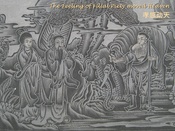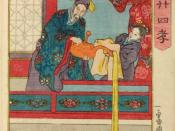It is quite interesting how sudden a particular dynasty gets replaced by another in a blink of an eye. It is also quite interesting to sit back and view the various changes being taken place, whether it calls for drastic measures or simply leaving things the way they are. Perhaps changes will allow for improvement and create a better society for all. But, if things are done one way and results are satisfactory, why change a good thing? Koryo, a dynasty founded and ruled by a military commander named Wang Kon (T'aego), did just that. It kept many of the female-centered features of Silla's social system, which will be discussed in the following paragraphs. (Kim, p11) During the declination of the Silla dynasty and the formation of the newly developed Koryo dynasty, social changes were minimal while the position of women remained quite similar in accordance with their family lifestyles, social class, governmental laws and rights, and as well, their cultural traditions.
Within the family lifestyles, the roles of a daughter, a wife, and a mother in both the Silla and Koryo dynasty remained relatively alike. In both dynasties, the women's position depended greatly on the status of her father, husband, and/or son. As a daughter, her duties were to respect her parents and help her mother with responsibilities such as household chores. As a wife and a mother, she had to take full responsibilities in the family by educating her children, managing a home, and other duties. As well, she was expected to manage the family's finances. Furthermore, as a virtuous wife, she must remain chaste for the rest of her life if her husband passed away. As discussed in the chapter of The Social System, "Filial piety was the prime virtue by which family lineage was preserved, and ancestor worship was its salient feature." (Kim, p13) Also, "Filial piety toward parents, warm concern for brothers and sisters, and service to the ancestors were important attributes of a virtuous woman." (Kim, p15) Both statements suggest that women in these two dynasties, whether in the position of a mother, wife, or daughter, must acquire filial piety in order to meet the expectations laid out by society. It is noted that if a woman failed in her duties of filial piety, especially towards her in-laws, harsh punishments were carried out by her husband. Such punishments included divorce and/or being expelled from their home. Filial piety and fidelity were considered as the most important ethical conduct. Neglecting piety in general and neglecting devotion toward one's parents is the greatest of all misconducts. (Kim, p14-15) Since virtuosity and piety were regarded highly and taken quite seriously, such lifestyles and ways of life remained the same and continued into the Koryo dynasty.
Within the social class of society, the importances of women's positions were beginning to falter due to social changes, which were taking place during the transition of the two dynasties. Changes were largely brought about by the introduction of Confucianism, which included the revision of the bone rank system and kinship organization. "One of the distinct features of Koryo society was the kinship unit of five generations which replaced the seven generation clan group as the basic unit of social organization." (Kim, p12) Since the bone rank system was discarded, a new class was created among the royal clan. Of course, King T'aejo made sure Silla's elite families maintain similar statuses as before. The ruling class consisted both the military and civil, was called the yangban. Below the yangban were the commoners (sangmin), and below them, existed the lowborn (ch'onmin). Even though there were class distinctions and strict rules for all to marry within their social classes, the people of Koryo enjoyed a more flexible class system than those of the Silla period. This is explained by, ""æ marriage in the upper class served in part to preserve power, marriage in the lower classes sometimes provided a means of climbing up the social ladder and accumulating wealth." (Kim, p14) This idea was practiced in the later periods of Silla, which was further carried out into the time or Koryo. Women were often deserted by their husbands for other women of higher status and wealth. Evidently, women of the higher class were more or less treated as objects and the vital importance of their roles were being compromised. As opposed to the more matriarchal ways practiced in the Silla period, Koryo decided to take the patriarchal direction, hence social changes were apparent.
Apparently, in the Silla time period, women's roles and their rights were more valued and expressed than in the Koryo time period. In the courts, Silla people valued having the bloodline stay within. And when there's no heir to the throne, they would allow a princess to take over, whereas in Koryo times, a king's illegitimate son would step forward, or a son-in law would, but never would the daughter take over. "Silla women had more legal rights and a relatively high status is society." (Kim, p7) Such rights can be seen carried out into the Koryo dynasty. Rights included something like property inheritance. Women, regardless of their marital status had almost equal rights with men. By almost, it is meant that the sons had priorities, especially in land inheritances, but for other properties such as slaves, claims were equal for both sons and daughters. Females were entitled to inheritances. They also had rights to access any inheritable properties. On the other hand, succession could not be assumed directly by the female, but only through her son. (Kim, P12) All the legitimate sons and grandsons came first, followed by the illegitimate sons and grandsons, then the daughters. Nonetheless, women's roles and their rights were quite similar in both the dynasties, but there were few obvious changes that is led to believe women's rights were more valued and expressed in the Silla time period.
Moreover, many cultural traditions that were more female oriented were practiced during the Silla period and as the Koryo dynasty came to, the traditions switched over to a male-oriented society. While in the courts, women had opportunities to rule and govern, the same emphasis on maternal lines was also practiced by women among the commoners. Daughters who were still single were allowed to head the family. (Kim, p8) Furthermore, events such as not being able to produce a son and carry on the family name would not result in a divorce. "Silla women had more legal rights and a relatively high status in society." and ""æwomen were accepted as full members of society." (Kim, p7) Even though her position as a woman relies slightly on the statuses of her husband and/or son, she was still seen as an individual and was respected based on her own abilities and merits. As the Koryo dynasty established itself, such ideas and traditions began to change. A woman's successes were depended not on her own merits, but those of her son's and husband's. For example, she would be honored and awarded because her son passed the government service exam. Also, divorce in the Koryo society was carried out only by the husband for reasons such as bearing no son, committing adultery, jealousy, and etc. These were the seven evils that originated from Confucian teachings. Under no circumstances, could a woman divorce her husband. It was common for richer men to have multiple wives and of course, the wives must not get jealous or have any say. Marriage too, had boundaries that were practiced in both Silla and Koryo. Marriages between persons with the same family name, between blood relations, and between different classes were prohibited. Even though there were these rules and traditions, people of Koryo often broke them and commit incest and adultery. "Affairs between men and women, both widowed and married, became common." (Kim, P14) Perhaps because the incidents were becoming more numerous, the traditional rules were strictly enforced. But later on in the period, intermarriage became prevalent among many members of the court and not the commoners. They would still be severely punished. Another tradition in marriage was that the bride had to supply household supplies and a wardrobe when she went over to her husband's home. Often poorer families would go into debt after marrying off their daughter. Therefore, many traditions that were practiced in the Silla period were more matrimonial while Koryo did carry some of the traditions into their time period, some of common practices of traditions were becoming more male-oriented.
In conclusion, During the declination of the Silla dynasty and the formation of the newly developed Koryo dynasty, social changes were minimal while the position of women remained quite similar in accordance with their family lifestyles, social class, governmental laws and rights, and as well, their cultural traditions.
Bibliography 1. Kim, Yung-Chung. Ancient Choson to Koryo. York University Course Kit: 2000.







